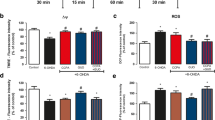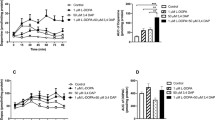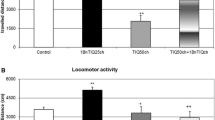Abstract
A2A adenosine receptor antagonists have been proposed as a new therapy for Parkinson’s disease (PD). Since oxidative stress plays an important role in the pathogenesis of PD, we studied the effect of the selective A2A adenosine receptor antagonists 8-(3-chlorostyryl)caffeine (CSC) and 4-(2-[7-amino-2-(2-furyl)[1,2,4]triazolo[2,3-a][1,3,5]triazin-5-ylamino]ethyl)phenol (ZM 241385) on l-3,4-dihydroxyphenylalanine (l-DOPA)-induced hydroxyl radical generation using in vivo microdialysis in the striatum of freely moving rats. l-DOPA (100 mg/kg; in the presence of benserazide, 50 mg/kg) given acutely or repeatedly for 14 days generated a high level of hydroxyl radicals, measured by HPLC with electrochemical detection, as the product of their reaction with p-hydroxybenzoic acid (PBA). CSC (1 mg/kg) and ZM 241385 (3 mg/kg) decreased haloperidol (0.5 mg/kg)-induced catalepsy, while at low doses of 0.1 and 0.3 mg/kg, respectively, they did not display an effect. CSC (1 and 5 mg/kg) and ZM 241385 (3 and 9 mg/kg) given acutely, or CSC (1 mg/kg) and ZM 241385 (3 mg/kg) given repeatedly, increased the production of hydroxyl radicals in dialysates from rat striatum. Both acute and repeated administration of CSC (0.1 and 1 mg/kg) and ZM 241385 (3 mg/kg) decreased l-DOPA-induced generation of hydroxyl radicals. However, a high single dose of either CSC (5 mg/kg) and ZM 241385 (9 mg/kg) markedly potentiated the effect of l-DOPA on hydroxyl radical production. The increase in hydroxyl radical production by acute and chronic injection of CSC and ZM 241385 may be related to the increased release of dopamine (DA) and its metabolism in striatal dialysates. Similarly, increased DA release following a single high dose of CSC or ZM 241385 appears to be responsible for augmentation of l-DOPA-induced hydroxyl radical formation. Conversely, the inhibition of l-DOPA-induced production of hydroxyl radical by single and repeated low doses of CSC or repeated low doses of ZM 241385 may be related to reduced DA metabolism. Summing up, A2A antagonists, used as a supplement of l-DOPA therapy, depending on the dose used, may have a beneficial or adverse effect on ongoing neurodegenerative processes and accompanying oxidative stress.






Similar content being viewed by others
Abbreviations
- aCSF:
-
Artificial cerebrospinal fluid
- AUC:
-
Area under the curve
- CSC:
-
8-(3-Chlorostyryl)caffeine
- DA:
-
Dopamine
- 3,4-DHBA:
-
3,4-Dihydroxybenzoic acid
- DMSO:
-
Dimethyl sulphoxide
- DOPAC:
-
3,4-Dihydroxyphenylacetic acid
- i.m.:
-
Intramuscular
- l-DOPA:
-
l-3,4-Dihydroxyphenylalanine
- HVA:
-
Homovanillic acid
- MAO:
-
Monoamine oxidase
- MPTP:
-
1-Methyl-4-phenyl-1,2,3,6-tetrahydropyridine
- PBA:
-
p-Hydroxybenzoic acid
- PD:
-
Parkinson’s disease
- SN:
-
Substantia nigra
- VMAT2:
-
Vesicular monoamine transporter-2
- ZM 241385:
-
4-(2-[7-Amino-2-(2-furyl)[1,2,4]triazolo[2,3-a][1,3,5]triazin-5-ylamino]ethyl)phenol
References
Aguiar LMV, Macêdo DS, Vasconcelos SMM, Oliveira AA, de Sousa FCF, Viana GSB (2008) CSC, an adenosine A2A receptor antagonist and MAO B inhibitor, reverses behavior, monoamine neurotransmission, and amino acid alterations in the 6-OHDA-lesioned rats. Brain Res 1191:192–199
Ascherio A, Zhang SH, Hernán MA, Kawachi I, Colditz GA, Speizer FE, Willett WC (2001) Prospective study of caffeine consumption and risk of Parkinson’s disease in men and women. Ann Neurol 50:56–63
Behan WMH, Stone TW (2002) Enhanced neuronal damage by co-administration of quinolic acid and free radicals, and protection by adenosine A2A receptor antagonists. Br J Pharmacol 135:1435–1442
Bishnoi M, Chopra K, Kulkarni SK (2007) Theophylline, adenosine receptor antagonist prevents behavioral, biochemical and neurochemical changes associated with an animal model of tardive dyskinesia. Pharmacol Rep 59:181–191
Block ML, Zecca L, Hong J-S (2007) Microglia-mediated neurotoxicity: uncovering the molecular mechanisms. Nat Rev Neurosci 8:57–69
Bové J, Serrats J, Mengod G, Cortés R, Tolosa E, Marin C (2005) Neuroprotection induced by the adenosine A2A antagonist CSC in the 6-OHDA rat model of parkinsonism: effect on the activity of striatal output pathways. Exp Brain Res 165:362–374
Buu NT, Angers M (1987) Effects of different monoamine oxidase inhibitors on the metabolism of L-DOPA in the rat brain. Biochem Pharmacol 36:1731–1735
Cenci MA (2007) Dopamine dysregulation of movement control in L-DOPA-induced dyskinesia. Trends Neurosci 30:236–243
Chen J-F, Huang Z, Ma J, Zhu J, Moratalla R, Standaert D, Moskowitz MA, Fink JS, Schwarzschild MA (1999) A(2A) adenosine receptor deficiency attenuates brain injury induced by transient focal ischemia in mice. J Neurosci 19:9192–9200
Chen J-F, Xu K, Petzer JP, Staal R, Xu YH, Beilstein M, Sonsalla PK, Castagnoli K, Castagnoli N Jr, Schwarzschild MA (2001) Neuroprotection by caffeine and A(2A) adenosine receptor inactivation in a model of Parkinson’s disease. J Neurosci 21:RC143
Chen J-F, Steyn S, Staal R, Petzer JP, Xu K, Van der Schyf CJ, Castagnoli K, Sonsalla PK, Castagnoli N Jr, Schwarzschild MA (2002) 8-(3-Chlorostyryl)caffeine may attenuate MPTP neurotoxicity through dual actions of monoamine oxidase inhibition and A2A receptor antagonism. J Biol Chem 277:36040–36044
Chen J-F, Sonsalla PK, Pedata F, Melani A, Domenici MR, Popoli P, Geiger J, Lopes LV, de Mendonça A (2007) Adenosine A2A receptors and brain injury: broad spectrum of neuroprotection, multifaceted actions and “fine tuning” modulation. Prog Neurobiol 83:310–331
Chen L, Ding Y, Cagniard B, Van Laar AD, Mortimer A, Chi W, Hastings TG, Kang UJ, Zhuang X (2008) Unregulated cytosolic dopamine causes neurodegeneration associated with oxidative stress in mice. J Neurosci 28:425–433
Cleren C, Vilpoux C, Dourmap N, Bonnet J-J, Costentin J (1999) Acute interactions between L-DOPA and the neurotoxic effects of 1-methyl-4-phenylpyridinium or 6-hydroxydopamine in mice. Brain Res 830:314–319
Daré E, Schulte G, Karovic O, Hammarberg C, Fredholm BB (2007) Modulation of glial cell functions by adenosine receptors. Physiol Behav 92:15–20
Fahn S, Sulzer D (2004) Neurodegeneration and Neuroprotection in Parkinson’s Disease. NeuroRx 1:139–154
Gluck MR, Zeevalk GD (2004) Inhibition of brain mitochondrial respiration by dopamine and its metabolites: implications for Parkinson’s disease and catecholamine-associated diseases. J Neurochem 91:788–795
Gołembiowska K, Dziubina A (2004a) Effect of adenosine A2A receptor antagonist 8-(3-chlorostyryl)caffeine on L-DOPA biotransformation in rat striatum. Brain Res 998:208–217
Gołembiowska K, Dziubina A (2004b) Striatal adenosine A2A receptor blockade increases extracellular dopamine release following L-DOPA administration in intact and dopamine-denervated rats. Neuropharmacology 47:414–426
Halliwell B (2006) Oxidative stress and neurodegeneration: where we now? J Neurochem 97:1634–1658
Heikkila RE, Cohen G (1971) Inhibition of biogenis amine uptake by hydrogen peroxide: a mechanism for the toxic effects of 6-OHDA. Science 172:1257–1258
Ikeda K, Kurokawa M, Aoyama S, Kuwana Y (2002) Neuroprotection by adenosine A2A receptor blockade in experimental models of Parkinson’s disease. J Neurochem 80:262–270
Jana S, Maiti AK, Bagh MB, Banerjee K, Das A, Roy A, Chakrabarti S (2007) Dopamine but not 3,4-dihydroxyphenylacetic acid (DOPAC) inhibits brain respiratory chain activity by autoxidation and mitochondria catalyzed oxidation to quinine products: implications in Parkinson’s disease. Brain Res 1139:195–200
Jones PA, Smith RA, Stone TW (1998) Protection against kainate-induced excitotoxicity by adenosine A2A receptor agonists and antagonists. Neuroscience 85:229–237
Kanda T, Jackson MJ, Smith LA, Pearce RK, Nakamura J, Kase H, Kuwana Y, Jenner P (1998) Adenosine A2A antagonist: a novel antiparkinsonian agent that does not provoke dyskinesia in parkinsonian monkeys. Ann Neurol 43:507–513
Levitt P, Pintar JE, Breakfield XO (1982) Immunocytochemical demonstration of monoamine oxidase B in brain astrocytes and serotonergic neurons. Proc Natl Acad Sci USA 79:6385–6389
LeWitt PA, Guttman M, Tetrud JW, Tuite PJ, Mori A, Chaikin P, Sussman NM (2008) Adenosine A2A receptor antagonist istradefylline (KW-6002) reduces “Off” time in Parkinson’s disease: a double-blind, randomized, multicenter clinical trial (6002-US-005). Ann Neurol 63:295–302
Melani A, Pantoni L, Bordoni F, Gianfriddo M, Bianchi L, Vannucchi MG, Bertorelli R, Monopoli A, Pedata F (2003) The selective A2A receptor antagonist SCH 58261 reduces striatal transmitter outflow, turning behavior and ischemic brain damage induced by permanent focal ischemia in the rat. Brain Res 959:243–250
Migheli R, Godani C, Sciola L, Delogu MR, Serra PA, Zangani D, De Natale G, Miele E, Desole MS (1999) Enhancing effect of manganese on L-DOPA-induced apoptosis in PC12 cells: role of oxidative stress. J Neurochem 73:1155–1163
Morelli M, Di Paolo T, Wardas J, Calon F, Xiao D, Schwarzchild MA (2007) Role of adenosine A2A receptors in parkinsonian motor impairment and L-DOPA-induced motor complications. Prog Neurobiol 83:293–309
Nakao N, Nakai K, Itakura T (1997) Metabolic inhibition enhances selective toxicity of L-DOPA toward mesencephalic dopamine neurons in vitro. Brain Res 777:202–209
Ochi M, Koga K, Kurokawa M, Kase H, Nakamura J, Kuwana Y (2000) Systemic administration of adenosine A2A receptor antagonist reverses increased GABA release in the globus pallidus of unilateral 6-hydroxydopamine-lesioned rats: a microdialysis study. Neuroscience 100:53–62
Oreland L (1991) Monoamine oxidase, dopamine and Parkinson’s disease. Acta Neurol Scand 84(Suppl 136):60–65
Paxinos G, Watson C (1998) The rat brain in stereotaxic coordinates. Academic Press, San Diego
Phillis JW (1995) The effects of selective A1 and A2a adenosine receptor antagonists on cerebral ischemic injury in the gerbil. Brain Res 705:79–84
Pierri M, Vaudano E, Sager T, Englund U (2005) KW-6002 protects from MPTP induced dopaminergic toxicity in the mouse. Neuropharmacology 48:517–524
Pintor A, Galluzzo M, Grieco R, Pezzola A, Reggio R, Popoli P (2004) Adenosine A2A receptor antagonists prevent the increase in striatal glutamate levels induced by glutamate uptake inhibitors. J Neurochem 89:152–156
Pocock JM, Kettenmann H (2007) Neurotransmitter receptors on microglia. Trends Neurosci 30:527–535
Pollack AE, Fink JS (1995) Adenosine antagonists potentiate D2 dopamine-dependent activation of Fos in the striatopallidal pathway. Neuroscience 68:721–728
Popoli P, Pintor A, Domenici MR, Frank C, Tebano MT, Pèzzola L, Scarchilli L, Quarta D, Reggio R, Malchiodi-Albedi F, Falchi M, Massotti M (2002) Blockade of striatal adenosine A2A receptor reduces, through a presynaptic mechanism, quinolic acid-induced excitotoxicity: possible relevance to neuroprotective interventions in neurodegenerative diseases of the striatum. J Neurosci 22:1967–1975
Popoli P, Blum D, Pintor A, Tebano MT, Frank C, Gianfriddo M, Domenici MR, Schiffmann SN, Pedata F (2004) The controversial role of adenosine receptor antagonists as neuroprotective agents. Curr Med Chem – CNS Agents 4:35–45
Przedborski S, Jackson-Lewis V, Muthane U, Jiang H, Ferreira M, Naini A-B, Fahn S (1993) Chronic levodopa administration alters cerebral mitochondrial respiratory chain activity. Ann Neurol 34:715–723
Ross GW, Abbott RD, Petrovitch H, Morens DM, Grandinetti A, Tung K-H, Tanner CM, Masaki KH, Blanchette PL, Curb JD, Popper JS, White LR (2000) Association of coffee and caffeine intake with the risk of Parkinson disease. JAMA 283:2674–2679
Rowe DB, Le W, Smith RG, Appel SH (1998) Antibodies from patients with Parkinson’s disease react with protein modified by dopamine oxidation. J Neurosci Res 53:551–558
Saha AR, Ninkina NN, Hanger DP, Anderton BH, Davies AM, Bchman VL (2003) Induction of neuronal death by alpha-synuclein. Eur J Neurosci 12:3073–3077
Saura J, Angulo E, Ejarque A, Casadó V, Tussell JM, Moratalla R, Chen J-F, Schwarzschild MA, Lluis C, Franco R, Serratosa J (2005) Adenosine A2A receptor stimulation potentiates nitric oxide release by activated microglia. J Neurochem 95:919–929
Schwarzschild MA, Agnati L, Fuxe K, Chen J-F, Morelli M (2006) Targeting adenosine A2A receptors in Parkinson’s disease. Trends Neurosci 29:647–654
Serra PA, Esposito G, Enrico P, Mura MA, Migheli R, Delogu MR, Miele M, Desole MS, Grella G, Miele E (2000) Manganese increases L-DOPA auto-oxidation in the striatum of the freely moving rat: potential implications to L-DOPA long-term therapy of Parkinson’s disease. Br J Pharmacol 130:937–945
Simon P, Langwiński R, Boissier JR (1969) Comparaison de diffĕrents tests d’ĕvaluation de la catalepsie chez le rat. Thĕrapie 24:985–995
Tozzi A, Tscherter A, Belcastro V, Tantucci M, Costa C, Picconi B, Centonze D, Calabresi P, Borsini F (2007) Interaction of A2A adenosine and D2 dopamine receptors modulates corticostriatal glutamatergic transmission. Neuropharmacology 53:783–789
Von Lubitz DK, Lin RC, Jacobson KA (1995) Cerebral ischemia in gerbils: effects of acute and chronic treatment with adenosine A2A receptor agonist and antagonist. Eur J Pharmacol 287:295–302
Wardas J, Konieczny J, Lorenc-Koci E (2001) SCH 58261, an A2A adenosine receptor antagonist, counteracts parkinsonian-like muscle rigidity in rats. Synapse 41:160–171
Wu DC, Teismann P, Tieu K, Vila M, Jackson-Lewis V, Ischiropoulos H, Przedborski S (2003) NADPH oxidase mediates oxidative stress in the 1-methyl-4-phenyl-1,2,3,6-tetrahydropyridine model of Parkinson’s disease. Proc Natl Acad Sci USA 100:6145–6150
Xu K, Bastia E, Schwarzschild M (2005) Therapeutic potential of adenosine A2A receptor antagonists in Parkinson’s disease. Pharmacol Ther 105:267–310
Acknowledgments
The study was supported by the grant no 2PO5F 04427 awarded by the Ministry of Science and Higher Education.
Author information
Authors and Affiliations
Corresponding author
Rights and permissions
About this article
Cite this article
Gołembiowska, K., Dziubina, A., Kowalska, M. et al. Effect of Adenosine A2A Receptor Antagonists on l-DOPA-Induced Hydroxyl Radical Formation in Rat Striatum. Neurotox Res 15, 155–166 (2009). https://doi.org/10.1007/s12640-009-9016-2
Received:
Revised:
Accepted:
Published:
Issue Date:
DOI: https://doi.org/10.1007/s12640-009-9016-2




